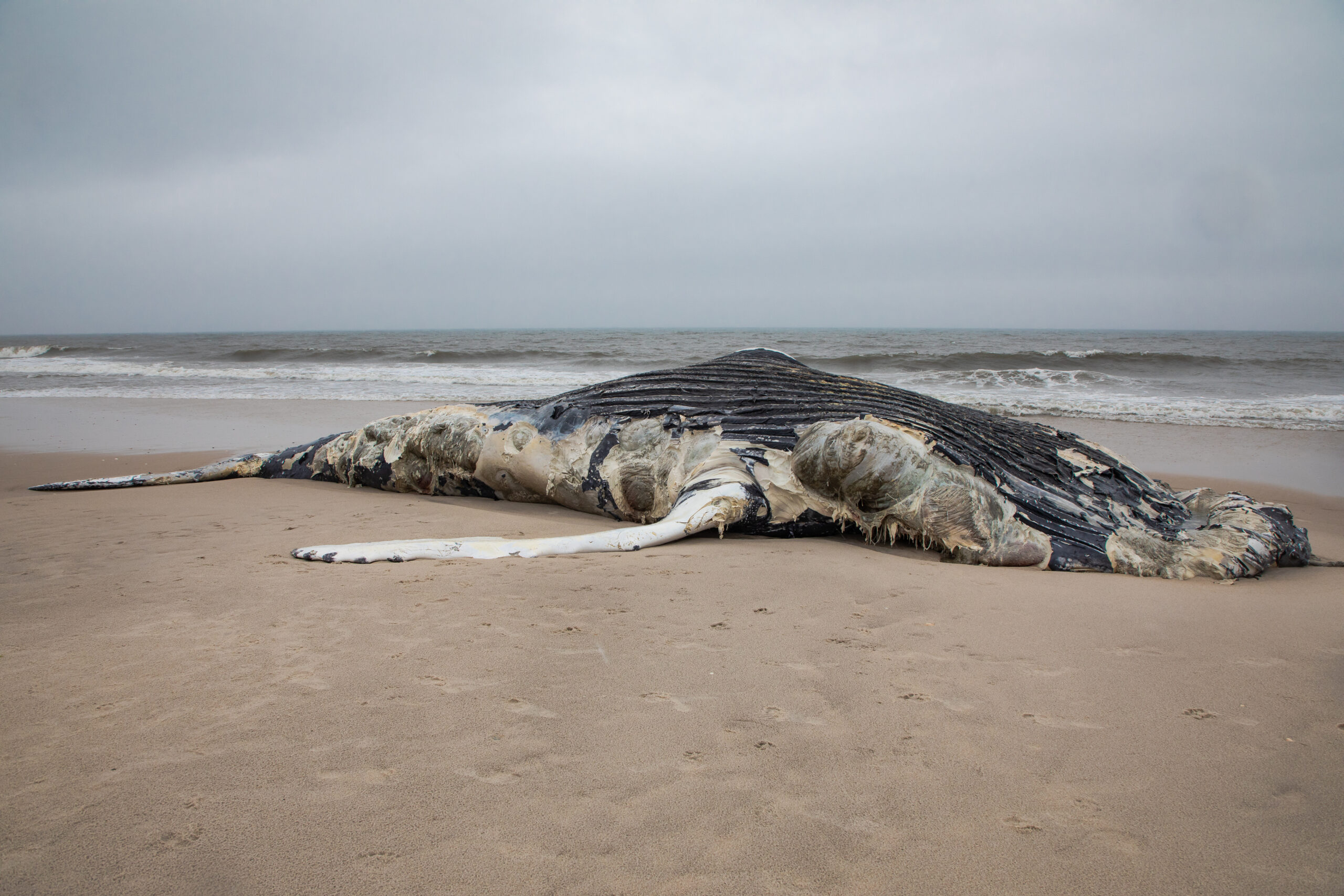Increase in Whale Deaths Along Eastern Atlantic Coast: What Is Causing The Ongoing Crisis?

NEW YORK, NY – The Eastern Atlantic coast continues to experience elevated whale mortality rates that have prompted federal officials to declare multiple Unusual Mortality Events (UMEs). The humpback whale UME began in January 2016 yet remains ongoing nearly a decade later.
According to the latest data from the National Oceanic and Atmospheric Administration (NOAA), 255 humpback whales have died along the Atlantic coast from Maine to Florida since 2016. The deaths peaked in 2023 with 37 fatalities, followed by 31 in 2024, and 12 already recorded in early 2025.
Recent data shows a concerning uptick in whale strandings across New England. In 2024, 28 dead whales washed ashore in Rhode Island and Massachusetts combined, compared to 16 in 2023, two in 2022, and 18 in 2021. The geographic distribution remains concentrated, with New York recording 47 total humpback whale deaths since 2016, while New Jersey has documented 35 deaths during the same period.
The critically endangered North Atlantic right whale population faces an even more dire situation. Since 2017, this species has been experiencing its own UME, with 41 documented deaths representing over 10% of the remaining population of approximately 370 individuals. The species’ reproduction rate has also declined dramatically, with females now having calves every six to ten years instead of every three years.
Speculation: Offshore Wind Development Claims
The most controversial speculation centers on offshore wind turbine construction and surveying activities being the cause. For instance, Nassau County Executive Bruce Blakeman and other officials have claimed that “huge wind turbines are a danger to marine life” and called for investigations into potential connections.
Critics argue that seismic surveys and construction noise from offshore wind projects could be “driving whales crazy” and causing navigation confusion. Some have demanded moratoriums on wind development until definitive answers are provided about impacts on marine life.
However, NOAA concluded in a January report that there is “no known connection” between offshore wind activity and whale deaths. Multiple federal agencies including the Bureau of Ocean Energy Management and Marine Mammal Commission have found no evidence linking wind activities to whale mortality. Scientists note that the whale mortality increase began in 2016, well before any significant offshore wind construction.
Speculation: Vessel Strike Theory
Marine scientists point to vessel strikes as the leading cause of whale deaths. Research indicates that vessel strikes increased threefold after 2016, coinciding with increased shipping traffic in whale foraging areas. The Port of New York and New Jersey has become the busiest port in the U.S., with cargo handling capacity increasing by 5.7% since 2021.
Studies show that 93% of humpback whale mortalities in the New York Bight caused by vessel strikes were juveniles. Experts argue that juvenile humpback whales foraging at the surface are particularly vulnerable to ship strikes in nearshore waters where vessel density and speed are highest.
Slowing vessel speeds to 10 knots reduces a North Atlantic right whale’s risk of death from vessel strikes by between 80% to 90%. However, compliance with speed regulations remains poor, with non-compliance rates as high as 90% in mandatory speed zones.
Fishing Gear Entanglement
Entanglement in fishing gear represents another major threat, particularly for North Atlantic right whales. Since 2017, 99 North Atlantic right whales have been reported in poor health, seriously injured or dead due to fishing gear entanglements.
Recent cases highlight the severity of this threat. In 2024, a young female right whale (#5120) died from chronic entanglement after spending nearly two years with rope cutting into her tail. The rope had been entangled around the whale since 2022, slowly cutting through flesh and bone until her death in January 2024.
Current data shows that entanglements in fishing gear used to catch lobster, crab, and other species is another leading cause of North Atlantic right whale deaths. In December 2024, two more right whales were found entangled off Nantucket, with NOAA determining that one is “likely to die from this injury”.
Speculation: Climate Change and Environmental Factors
Some scientists speculate that climate change may be contributing to whale deaths indirectly. Rising ocean temperatures due to “human-caused climate change caused primarily by the burning of fossil fuels” forces whale food sources like menhaden to move closer to shore, bringing whales into greater conflict with human activities.
Food sources for whales are forced to adapt to rising temperatures by moving landward to more favorable locations. Whales follow their food source, and the closer to land they get, the more likely they are to come into conflict with human activities.
Speculation: Competing Narratives and Political Dimensions
The whale death crisis has become entangled in broader political debates about renewable energy development. Conservative groups and fossil fuel interests have used whale deaths as a rallying point against offshore wind development, despite scientific evidence showing no connection.
Former President Donald Trump has claimed that wind turbines are “causing whales to die in numbers never seen before,” though fact-checkers note his claims are not backed by evidence. These politically motivated claims have spread widely on social media, with hundreds of posts wrongly linking wind farms to whale deaths garnering hundreds of thousands of views.
Marine scientists express frustration with the misinformation campaign. Duke University’s Douglas Nowacek stated there are “no links whatsoever between the offshore wind development activity and especially the humpback whale mortalities. None. Zero”[referenced from previous conversation].
Speculation: Ongoing Research and Monitoring
Despite the lack of evidence linking wind farms to whale deaths, extensive monitoring programs are underway, including a $26 million research program in New Jersey funded by offshore wind companies. Research includes acoustic monitoring devices on the ocean floor, vessel-based surveys, and comprehensive necropsy examinations.
The scientific consensus remains clear that vessel strikes and fishing gear entanglements, not offshore wind turbines, are the primary documented causes of the whale mortality crisis. However, the speculation and political controversy continue to generate headlines and public concern as whale deaths persist along the Eastern Atlantic coast.
The ongoing crisis underscores the urgent need for effective conservation measures, including stricter vessel speed enforcement, improved fishing gear technologies, and continued monitoring to protect these endangered marine mammals from further population declines.
Quick Q&A: Whale Deaths on the Rise Along the East Coast
Q1: How many whales have died along the Eastern Seaboard recently?
A1: Since 2016, over 200 humpback whale deaths have been recorded from Maine to Florida, with a noticeable spike in recent years, particularly in the New York and New Jersey areas.
Q2: Which species are being most affected?
A2: The most commonly affected species include humpback whales, North Atlantic right whales, and minke whales.
Q3: What are the leading suspected causes of these whale deaths?
A3: Primary causes include vessel strikes and entanglements in commercial fishing gear. Some theories also point to changes in feeding patterns driven by warming waters.
Q4: Has offshore wind development been ruled out as a cause?
A4: NOAA and other federal agencies have stated that no direct evidence currently links offshore wind projects to the whale deaths, although investigations are ongoing.
Q5: Are any federal or state investigations underway?
A5: Yes, NOAA has declared an “Unusual Mortality Event” for multiple whale species, triggering enhanced monitoring and response protocols.
Q6: Is climate change a contributing factor?
A6: Scientists believe shifting ocean temperatures and fish migration patterns may be forcing whales closer to shore, increasing their risk of ship strikes and gear entanglement.
Q7: Are Long Island and New Jersey seeing more strandings than usual?
A7: Yes, both regions have seen a higher-than-average number of whale strandings and deaths in recent years, raising local concern.
Q8: What is being done to prevent future whale deaths?
A8: Efforts include rerouting shipping lanes, slowing vessel speeds in certain areas, improving fishing gear regulations, and expanding research into whale behavior and habitat changes.
Q9: How can the public help?
A9: Residents can report stranded or dead marine mammals to local authorities, support responsible marine conservation organizations, and advocate for safer shipping practices.
Q10: Is this crisis receiving national attention?
A10: Yes, the growing number of whale deaths is sparking national debate over environmental policies, commercial development at sea, and climate impacts on marine ecosystems.


